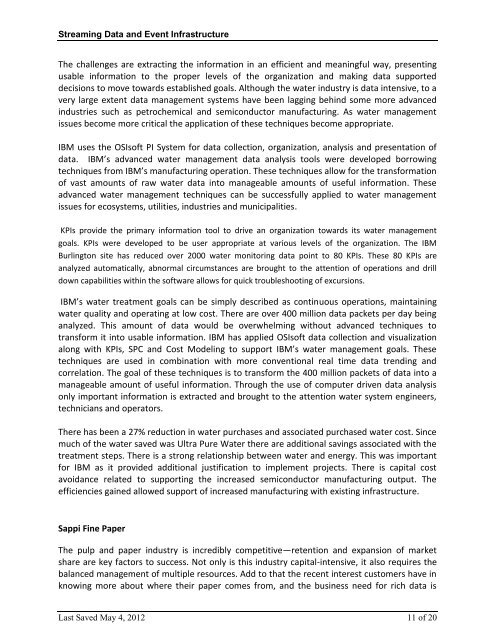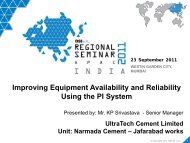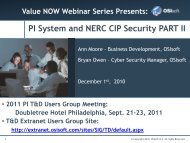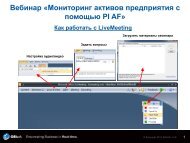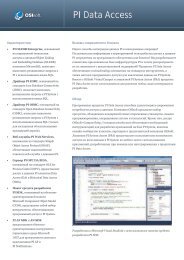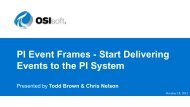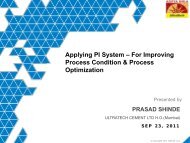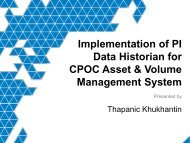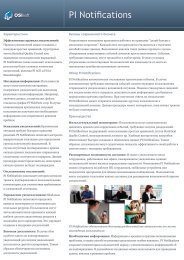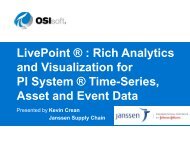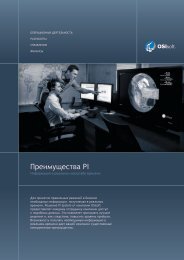Streaming Data and Event Infrastructure - OSIsoft
Streaming Data and Event Infrastructure - OSIsoft
Streaming Data and Event Infrastructure - OSIsoft
You also want an ePaper? Increase the reach of your titles
YUMPU automatically turns print PDFs into web optimized ePapers that Google loves.
<strong>Streaming</strong> <strong>Data</strong> <strong>and</strong> <strong>Event</strong> <strong>Infrastructure</strong><br />
The challenges are extracting the information in an efficient <strong>and</strong> meaningful way, presenting<br />
usable information to the proper levels of the organization <strong>and</strong> making data supported<br />
decisions to move towards established goals. Although the water industry is data intensive, to a<br />
very large extent data management systems have been lagging behind some more advanced<br />
industries such as petrochemical <strong>and</strong> semiconductor manufacturing. As water management<br />
issues become more critical the application of these techniques become appropriate.<br />
IBM uses the <strong>OSIsoft</strong> PI System for data collection, organization, analysis <strong>and</strong> presentation of<br />
data. IBM’s advanced water management data analysis tools were developed borrowing<br />
techniques from IBM’s manufacturing operation. These techniques allow for the transformation<br />
of vast amounts of raw water data into manageable amounts of useful information. These<br />
advanced water management techniques can be successfully applied to water management<br />
issues for ecosystems, utilities, industries <strong>and</strong> municipalities.<br />
KPIs provide the primary information tool to drive an organization towards its water management<br />
goals. KPIs were developed to be user appropriate at various levels of the organization. The IBM<br />
Burlington site has reduced over 2000 water monitoring data point to 80 KPIs. These 80 KPIs are<br />
analyzed automatically, abnormal circumstances are brought to the attention of operations <strong>and</strong> drill<br />
down capabilities within the software allows for quick troubleshooting of excursions.<br />
IBM’s water treatment goals can be simply described as continuous operations, maintaining<br />
water quality <strong>and</strong> operating at low cost. There are over 400 million data packets per day being<br />
analyzed. This amount of data would be overwhelming without advanced techniques to<br />
transform it into usable information. IBM has applied <strong>OSIsoft</strong> data collection <strong>and</strong> visualization<br />
along with KPIs, SPC <strong>and</strong> Cost Modeling to support IBM’s water management goals. These<br />
techniques are used in combination with more conventional real time data trending <strong>and</strong><br />
correlation. The goal of these techniques is to transform the 400 million packets of data into a<br />
manageable amount of useful information. Through the use of computer driven data analysis<br />
only important information is extracted <strong>and</strong> brought to the attention water system engineers,<br />
technicians <strong>and</strong> operators.<br />
There has been a 27% reduction in water purchases <strong>and</strong> associated purchased water cost. Since<br />
much of the water saved was Ultra Pure Water there are additional savings associated with the<br />
treatment steps. There is a strong relationship between water <strong>and</strong> energy. This was important<br />
for IBM as it provided additional justification to implement projects. There is capital cost<br />
avoidance related to supporting the increased semiconductor manufacturing output. The<br />
efficiencies gained allowed support of increased manufacturing with existing infrastructure.<br />
Sappi Fine Paper<br />
The pulp <strong>and</strong> paper industry is incredibly competitive—retention <strong>and</strong> expansion of market<br />
share are key factors to success. Not only is this industry capital-intensive, it also requires the<br />
balanced management of multiple resources. Add to that the recent interest customers have in<br />
knowing more about where their paper comes from, <strong>and</strong> the business need for rich data is<br />
Last Saved May 4, 2012 11 of 20


